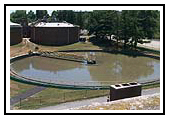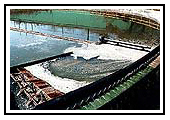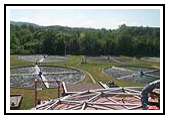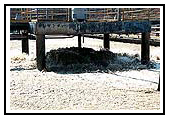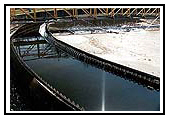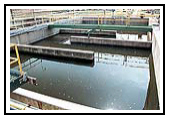| |
WASTE
WATER TREATMENT SYSTEMS
Once
collected, sewage water flows into a generally unappreciated but
highly important multi-step treatment facility. There are numerous
variations on the treatment plant theme, but they all work to achieve
the same goals:
• remove sludge and scum so they don't accumulate in rivers
where the water is discharged,
• prevent oxygen-demanding organic material from entering
rivers where it kills aquatic life by stealing oxygen,
• prevent odors created in water lacking enough dissolved
oxygen, and
• remove potential disease-causing bacteria and viruses (pathogens).
The
preliminary or first step in wastewater treatment removes large
objects (roots, rags, cans, body parts, pianos) by screening the
water through a grate or bar screen made of parallel bars. Every
so often, collected materials are raked off the screen and disposed
of by burning or burying. Some plants automatically shred (grind)
these materials and leave the pieces in the wastewater flow for
later removal.
While the screening process removes large objects, it does nothing
about sand and grit, which has to be removed so it doesn't ruin
pumps and other equipment. Grit is often removed in grit channels
or a grit tank. Grit tanks are know as detritors where water flow
is slowed enough to let heavy inorganic materials (grit) settle.
Many plants aerate the water to help separate the grit. A grit screw
like the one on the right removes such settled grit from the water
so it can be removed manually for disposal.
After
grit is removed, water begins primary treatment in a large basin
or tank (left), called a primary clarifier, where solids (called
sludge) settle and light materials (grease, oil, light solids) float.
Primary
treatment helps clear the water. In round clarifiers, an arm or
"plow" with a scraper blade and squeegees rotates around
the bottom to guide sludge into a collection pipe for removal where
the sludge is pumped to a digester. Scum on the surface, in the
picture at the right, is pushed (skimmed) by a skimmer arm into
an effluent trough for ultimate disposal in the digester. The term
effluent is used to refer to any wastewater or related liquid leaving
a treatment unit.
In
a rectangular clarifier, sludge is collected by a continuously moving
collector chain that acts like a kind of conveyor belt and drags
the sludge to a collection point where it is removed. At the same
time, floating scum is skimmed and removed from the surface through
scum skimmer troughs. Water leaves the clarifiers by flowing over
a weir, a steel "curb" with teeth that allows the water
to flow slowly. You could imitate this overflow process if you put
a glass under the kitchen spigot and let water flow in at a rate
just fast enough so that it flows out over the edges slowly.
Solids and collected scum that is removed from the primary clarifier
is sent to another big tank (left)the digester where the solids
(sludge) is allowed to be decomposed by microorganisms over a long
period of time. In my home town the digestion time is about 14 days.
Digestion can occur under anerobic conditions (without oxygen) or
aerobic conditions (with oxygen).
When water leaves a primary treatment clarifier, it flows to secondary
or biological treatment, which exposes it to bacteria that "eat"
dissolved and organic materials still floating in the water.
Biological treatment takes place in trickling filters and/or aeration
tank. A trickling filter (right in rear of photo) is a large circular
ground-level tank filled with rocks that form a filter bed. The
one shown here is about 5 feet deep. Two arms spanning the diameter
of the tank rotate and spray (more like dribble) water over the
rocks, which grow an algae beard that thrives on the organic materials.
When the algae beard gets too thick, the spray is turned off to
let the bed dry out so the algae will die.
One common biological treatment unit is an aeration tank (left).
Removal is accomplished by feeding bacteria into the water, keeping
the water warm if possible to encourage growth, and providing lots
of oxygen with aerators (one big "egg beater" is shown
at right) to encourage the bacteria to grow by feeding on the organic
matter. This is called biological treatment. Water in enclosed buildings
is easier to keep warm than tanks outside, so how warm the water
is affects whether and how much the tank must be aerated with ambient
air or pure oxygen (from a tank). Using pure oxygen is more efficient
than using plain old air, which doesn't have nearly as much oxygen
in it, but plain old air is free.
In an aeration tank, the microorganisms eat the organic matter and
remove pollutants. The effluent from the aeration tank is referred
to as mixed liquor suspended solids.
Many treatment plants then pipe the water into more clarifiers (left)
or leveling ponds to let more sludge settle. Some of this activated
sludge, which is even more fluffy than the sludge produced earlier,
is recycled to the aeration tanks to keep the bacterial process
going. Leftover sludge can be sent to digester tanks and aerator
tanks for more bacterial processing and then the water can be recycled
for reprocessing. Eventually water flows into a final clarifier
where it looks and is visibly free of sludge (right).
Digested sludge can be processed in a variety of ways, which include
spinning in centrifuges (like the spin cycle in a clothes washer),
and dewatering to remove as much water as possible and turn the
sludge into a cake-like consistency--the drier the better. A polymer
(chemical) is sometimes added to help this dewatering process along.
Among the things that can be done with sludge is to incinerate it,
dispose of it in landfills, and process it to make marketable fertilizer.
In the final treatment steps, chlorine is added to kill leftover
bacteria. The tank shown here (left) is one of two at my local plant
that provides "a lot of contact time" between the chlorine
and the water to kill the pathogens (disease-carrying organisms).
Most plants discharge water into a river.
|
|


